List of Agroforestry Niches
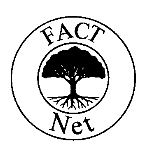
Farm Borders
Borders around farmland form a significant niche in which trees may be planted. Traditionally farm borders have been heavily exploited for tree planting by farmers. Borders include those with neighboring lands, internal boundaries that sub-divide the farm, and borders around the house. As farm borders typically include unproductive land, tree planting in this niche can increase overall farm outputs. Three categories are discussed below: 1) Hedges and 2) living fences are kept pruned low and have less direct influence on adjacent farmland. 3) Windbreaks are allowed to grow to larger sizes, and influence a larger portion of the farm land.
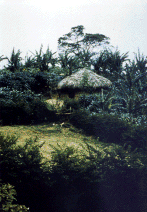
System: Hedge
Site: Africa
Species: Caesalpinia spp. (not a NFT)
Hedges act as barriers and protection, as in this livestock paddock in Africa.
Hedges are an important component of a farm. Both hedges and living fences (discussed below) protect crops from large roaming pests such as wildlife, domestic animals, and man. They also mark borders, provide privacy, and act as micro-windbreaks. Hedges are often planted and managed for fuelwood, fodder production and green manure.
Trees for hedges are planted very close together. For example, a typical planting is with trees in double rows 0.5 meters apart, with trees also 0.5 meters apart within the rows. Hedges require frequent trimming to the desired form (height, width, and shape) to encourage secondary branching, and thus an impenetrable hedge.
NFT genera of particular importance for hedges include Acacia, Pithecellobium and Prosopis. The species of importance in these genera are typically thorny, a particularly good characteristic for keeping out large animals. Casuarina also can be formed into a thick hedge.
Living Fences
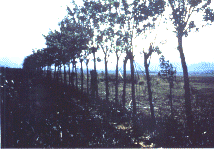
System: Living Fence
Site: Honduras
Species: Gliricidia sepium
Living fences support fencing materials, such as barbed wire, while providing fuelwood, animal feed and other products.
Living fences are similar to hedges in function, and the distinction between them is somewhat arbitrary. However, in living fences trees typically are: managed less intensively (ex., cut less often), planted further apart, and the tree is used together with other materials (barbed wire, wooden slats, etc.) to form the barrier. Often trees in living fences are allowed to grow to larger sizes than with hedges. NFT genera of particular importance as living fences include: Erythrina and Gliricidia which can serve as fences and sources of fuelwood and fodder.
Windbreaks
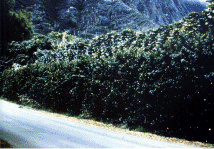
System: Windbreaks
Site: Hawaii
Species: Erythrina variegata with small hibiscus hedge in front
Windbreaks can improve crop yields because of decreased evapotranspiration downwind of the trees.
Windbreaks are single or multiple rows of trees planted along windward field boundaries. By slowing wind speeds, windbreaks help conserve soil moisture and prevent wind erosion, and therefore increase crop yields. (Crops immediately next to the windbreak may be adversely affected by competition, such as shade.) Border plantings are one of the best niches to exploit for the production of tree products (poles, timber, fuelwood, etc.), and windbreaks serve this duel role making them important even when winds are not a crucial problem.
Windbreaks can be planted in a variety of spacings and arrangements. A single row of trees can form a reasonable windbreak for small farms with limited space, particularly when planted with a hedge. For windy areas, a three tiered windbreak is recommended (a hedge, a row of medium-sized trees, and a row of larger trees).
Windbreak trees do not necessarily require extensive management. They can be allowed to grow and serve solely their windbreak function. Depending on species, they can also be pollarded to encourage lateral growth and provide needed tree products. Trees can be harvested from windbreaks but this should be planned to avoid gaps in the windbreak, especially during crop seasons. Winds can be “funnelled” through gaps leading to adverse effects on crops inside the gap, canceling positive gains from the intact windbreak.
Windbreaks can be planted with a wide range of species. Tree form is important, but not critical. Trees with a dense canopy and a large surface area will reduce wind speed the best. Farmer’s needs for tree products can play into species choice, ex., if fodder is needed, then fodder trees should be used in the windbreak.
Important NFT genera for a medium-sized windbreak include: Acacia (particularly Australian species), Alnus, Calliandra, Erythrina, Inga, Leucaena, Pithecellobium, Pongamia, Robinia, and Tipuana.
Most appropriate NFTs for tall windbreaks come from the genera Acacia (particularly Australia), Albizia, Casuarina, Dalbergia, Mimosa, Parkia, Paraserianthes, and Pterocarpus.
Trees in Crop Fields

System: Hedgerow intercropping
Site: Philippines
Species: Leucaena leucocephala interplanted with beans
Sloping Agricultural Lands Technology (SALT), a type of alley farming, uses NFTs to control erosion and improve soils.
NFTs have distinct potential as a source of fixed nitrogen for improving farm productivity when interplanted with agricultural crops. Additional advantages occur in microclimatic improvement, nutrient cycling, and soil conservation. Appropriate planting and management techniques can make large amounts of nitrogen and other nutrients available to the associated crops. This is especially true of the intensive management of hedgerows intercropping (alley farming). In contrast, wide-row intercropping is a less intensive system with more emphasis on tree products. The use of trees for crop shade (“nurse trees”) places emphasis on microclimatic improvements for associated crops. And finally, trees are also used as support for vining crop species.
Rows of trees should be planted on contour lines, now universally advised. Planting of trees on contours not only leads to improved erosion control, but also forms a permanent marker on the contours for the farmer. Tree rows can lead to the natural formation of terraces, especially when planted in association with grasses and other plants on the contour. Planting trees on established terrace edges can help in stabilizing the terrace, while providing new tree products.
Hedgerow Intercropping
Hedgerow intercropping is a management-intensive system that can lead to increases in crop yields. This management strategy seeks to maximize trees’ service roles of nitrogen fixation, soil and water conservation, weed control, and nutrient cycling. Hedgerow intercropping can lead to soil and micro-environmental improvements directly affecting associated crops. In addition, other tree products such as fuelwood and animal feed can be produced.
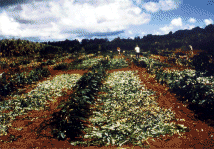
System: Hedgerow intercropping
Site: Hawaii
Species: (Foreground) Cassia siamea (non NFT)
Hedgerows are kept cut back during cropping seasons, and leaves and green stems applied as mulch.
Hedgerow intercropping, also referred to as alley farming or alley cropping, involves planting rows of trees 2 to 6 meters apart with crops cultivated between the rows or in the “alleys”. During the crop season, the hedgerows are kept pruned and the leaves and green stems are applied to the soil surface or incorporated into the soil. Hedgerows can be allowed to grow between cropping seasons to produce fuelwood.
On sloping land, hedgerows are densely planted (5-10 cm within rows) along the contours to form a barrier against soil erosion. Grass strips planted alongside hedgerows will create a more effective barrier.
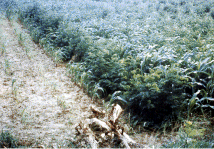
Important genera for hedgerow intercropping include Albizia, Cajanus, Calliandra, Gliricidia, Leucaena, and Sesbania. Promising genera which deserve further attention include: Chamaecytisus, Desmodium, Erythrina, Flemingia, Inga, and Tephrosia.
System: Hedgerow intercropping
Site: Kenya
Species: Leucaena leucocephala intercropped with maize
Maize yields were dramatically improved in this alley farming trial (right). A control plot without trees is on the left.
Wide-row Intercropping
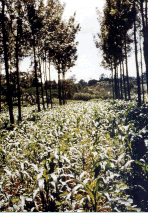
System: Wide-row intercropping
Site: Kenya
Species: Grevillea robusta (non NFT)
Wide-row intercropping provides important tree products with little adverse affect to crop yields.
Wide-row intercropping is practiced principally for the production of tree products (e.g., poles, timber, fruits). Wide spacings between rows (e.g., 10-20 meters) are used to avoid negative impact on the associated crops because the trees are grown to large sizes. Planting trees in wide rows divides the farm into a series of narrow fields with trees bordering each field. It is recommended that the trees be planted on contours. Trees can initially be planted fairly close within the rows (e.g., 1-2 meters), and later thinned as the trees reach usable sizes (ex., small poles).
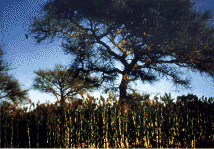
System: Wide-row intercropping
Site: Africa
Species: Faidherbia (Acacia) albida planted with millet.
Wide-row intercropping is the same idea as the common practice of leaving scattered trees in the fields.
A typical indigenous practice is to allow some trees which have come up naturally to grow in a scattered arrangement in the field. This is basically the same as wide-row intercropping. However, uniform spacing and contour planting ensures uniform treatment (microclimatic), ease in mechanized operations, and enables conversion to alternate crops without necessitating removal of the trees.
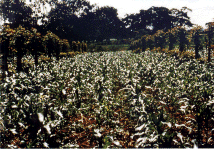
System: Wide-row intercropping
Site: Kenya
Species: Cassia siamea (non NFT)
Large trees in crop fields can be pollarded to reduce competition and provide green manure, animal feed and fuelwood.
In wide-row intercropping, tree canopies can be managed through periodic pollarding, or other forms of canopy management, to reduce shade competition. This should coincide with the cropping season to reduce shade.
Important genera for wide-row intercropping are generally similar to those recommended for windbreaks. Again, final species choice should be largely determined by what tree product the individual farmer wants.
Shade and Nurse Trees
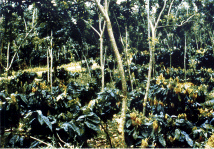
System: Shade Trees
Site: Indonesia
Species: Gliricidia sepium with Cacao
Shade trees provide microclimatic and soil improvements for associated shade loving crops.
Related to wide row intercropping is the practice of planting trees with crops for micro-climatic as well as soil improvements. This is typically done with shade-loving crops such as coffee, tea, and cacao.
If trees are planted for shade, usually geometric spacings are used, often in quite wide spacings. It is suggested that tree rows be planted along the contours with spacings between trees within rows about equal to the spacing between rows. This, again, ensures uniform treatment (shade) and ease in mechanized operations.
Shade trees can be managed through periodic pollarding to reduce shade competition. Important NFT genera for shade trees include Erythrina, Gliricidia, and Leucaena.
Support Trees
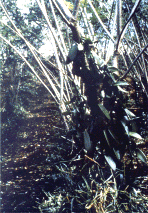
System: Support trees
Site: Costa Rica
Species: Gliricidia sepium with vanilla
Trees can support vining crops such as vanilla, yams, passion fruit and black pepper.
Many crop plants require support of some type upon which to grow, including passion fruits, pepper, vanilla, and yams. Trees have often been used as a form of live support. In such cases, the vining crop can benefit from the trees service roles, while some tree products might also be harvested.
Spacing depends on the vine crop, but spacings are typically close and geometrical. The tree canopy can be pollarded to control shading. The tree can also be girdled, resulting in a dead trellis up which the vine can grow. The tree will coppice from below the girdled area, and this can be periodically cut and applied as green manure.
Genera that have been used for support trees are generally the same as those used in hedgerow intercropping: Gliricidia, Leucaena, and Sesbania.
Trees in Livestock Systems
Rural farmers typically raise a few animals for either home consumption (milk and meat), providing protein in the family’s diet, or for income generation, providing funds for school fees and other obligations. Procuring fodder for livestock is a burden, particularly during dry seasons. Livestock systems can be improved by incorporating NFTs. Two basic systems, described below, are similar to two of the “Trees in Crop Fields” systems previously described: Fodder banks are hedgerows which can be intercropped with fodder grasses as the interplanted crop, and pasture improvement utilizes wide row intercropping with pasture grasses.
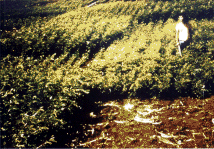
System: Fodder bank
Site: Hawaii
Species: Leucaena leucocephala
Fodder banks can be harvested on a rotational basis to provide an important protein supplement year round.
Fodder Banks. Fodder banks are intensive plantings of fodder trees, spaced to maximize leaf production and provide a source of “cut-and-carry” fodder. Many NFTs have leaves or pods that are high in protein. Trees with nutritious fodder can be either planted alone, or intercropped with other fodder plants, such as grasses.
Fodder banks can be planted near paddocks when zero-grazing is being practiced, or they can be planted directly in pasture areas. In the latter case, the fodder banks will have to be protected in some way or they will be destroyed. They can either be directly fenced off, in which case, during times of need, branches can then be harvested and thrown over the fence, or browsing will have to be strictly controlled through a pasture rotation system.
Trees in fodder banks are planted very close for maximum productivity. They can be intercropped with fodder grasses. The size and harvesting regime for the fodder bank should be designed to provide sufficient fodder when most needed. Systems can be designed to provide fodder only during the dry season, or to be harvested on a rotational basis, providing fodder year-round.
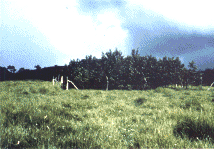
Important genera for fodder banks are similar to those for hedgerow intercropping, in particular, Gliricidia, Leucaena, and Sesbania
System: Fodder bank
Site: Costa Rica
Species: Guazuma ulmifolia (non NFT)
Fodder banks can be placed in pastures. During the dry season, branches are lopped off and thrown over the fence.
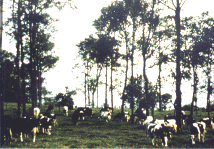
System: Pasture improvement
Site: Costa Rica
Species: Alnus acuminata
Better livestock yields are realized from pasture areas which include trees.
Pasture Improvement. Trees in pastures can enhance livestock production in two ways. First, trees can increase available animal food by increasing grass production within the field, and providing fodder directly (leaves and pods). Second, the livestock benefit from shade, as they digest food more efficiently when shade is available, particularly in hot climates.
As in wide row intercropping, trees are allowed to grow to large sizes. Wide planting arrangements are suggested for planting within pastures, because grass productivity will decrease with too much shade. It is suggested that trees be planted along the contours, so the pasture can be easily converted to crops without removing the trees.
A wide variety of trees have been used for pasture improvement, but a few genera stand out, particularly ones that shed edible, nutritious pods and/or leaves. These genera include: Acacia, Albizia, Alnus, Enterolobium, Gliricidia, Leucaena, and Prosopis.
Home Gardens
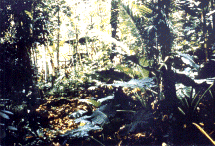
System: Home Gardens
Site: Ponape, Micronesia
Species: Coconut, banana, taro, breadfruit, and others (no NFTs)
Home gardens are characterized by their mix of many species, each plant of economic value.
Home gardens include diverse planting schemes. They are characterized by being planted in or near the family compound, and being composed of a variety of plants grown specifically for home consumption. Home gardens include simple systems, such as small vegetable gardens, and complex, multistory gardens found in various tropical areas, such as Southeast Asia and Africa.
NFTs can be incorporated into home gardens in two ways. First, NFTs can be productive components of the garden, yielding specific products. Second, NFTs can be planted to improve long-term productivity of the garden.
When trees are planted for their fruit, or other products, planting arrangements vary widely. Smaller species, such as Cajanus cajan, can be planted in rows with other crops interplanted. For many species, only one or two trees would be planted, often in no special arrangement.
Important genera for home gardens because of their edible products include Acacia, Cajanus, Inga, Leucaena, Parkia, Pentaclethra, Prosopis, and Sesbania.
Home garden productivity can be enhanced by practicing hedgerow intercropping for soil enrichment. The planting arrangement would need to be adapted to the specific companion crop(s), but the general concepts for the hedgerow intercropping apply. Key genera for this purpose would also be similar.
Shade / Ornamental
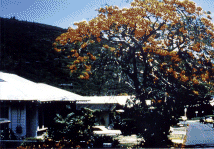
System: Shade / Ornamental
Site: Hawaii
Species: Delonix regia (non-NFT), common names include Poinciana and Flamboyant
Trees near homes provide shade and beauty, and can also yield products such as fruits.
Trees planted immediately around the house provide shade and thus cool the atmosphere. Animals living in or near houses also benefit. Species are often chosen which also produce fruits, or for their beauty.
Certain considerations need to be taken when planting trees near the home. Roots of trees planted too close can damage the foundation, while limbs can harm the roof. Also, trees should not be planted close to electrical or telephone lines, or underground plumbing. It is often advisable to manage the canopy by pollarding. This helps to avoid damage or injury in case a tree falls.
Common genera planted near the home include many that produce edible parts listed above. Additional genera include Albizia, Calliandra, Erythrina and Enterolobium.
Temporal Systems and Woodlots
Land-holders sometimes devote land solely to tree plantations. There are two basic purposes for solid stands of trees. First, is for the tree products such as fuel and timber (taungya systems and woodlots). The second is to improve soil conditions (improved fallow and land rehabilitation).
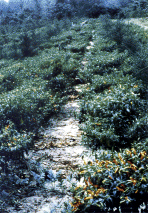
System: Taungya
Site: Thailand
Species: Casuarina equisetifolia with hot peppers
Newly established tree plantations can be intercropped providing crops for local farmers and better survival and growth for the trees.
Taungya. When trees plantations are being established, crops may be intercropped with the young seedlings for at least one cropping season, and often for several (until competition for light makes it no longer productive to continue). Trees are then left as pure stands with no additional uses of the land until after harvest. This agroforestry practice is called the Taungya system.
The taungya system is widely used by national forest departments in the tropics as an efficient method for plantation establishment. A typical practice is to allow local farmers to plant crops in newly planted government plantations. The farmer then gets to keep all crop products. The seedlings benefit from the agronomic practices given the crops: tillage, weeding, fertilizer, etc., leading to improved survival and early growth, and thus overall better plantation establishment.
The concept applies to other types of tree planting systems, such as woodlots, improved fallow and land rehabilitation.
In taungya, tree spacing is defined by the species, environment and the purpose of the tree planting, and is relevant to the taungya concept only in determining how long intercropping might continue. Tree species choice is also independent of the taungya practice, though NFTs would probably be better companion trees than non-NFTs.
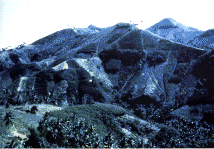
System: Improved fallow
Site: Philippines
Species: Leucaena leucocephala
Fallow periods can be considerably shortened by enrichment planting with NFTs.
Improved Fallow. Planting trees to improve fallow periods is applicable in areas where shifting cultivation is practiced. NFTs can be planted to enhance soil amelioration, and reduce fallow periods.
Trees can be purposefully planted (e.g., though a handful of scattered seeds) in land that is being abandoned. The use of NFTs in this way can lead to quicker rejuvenation of the soil as well as tree products.
Important genera used to improve fallow are similar to those used for hedgerow intercropping.
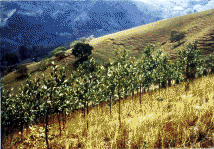
System: Land Rehabilitation
Site: Costa Rica
Species: Acacia mangium
Over-grazed, or other unproductive sites can be put to productive use by planting trees, which also help to restore the soil.
Land Rehabilitation. Land rehabilitation is long-term fallow for land that has been so over-exploited, or impacted in some way, that it has no short-term potential for productive agriculture. In such lands, trees can be planted to both provide products, and to gradually rehabilitate the soil.
In land rehabilitation, trees are planted in wider spacings, as in a plantation, since they are expected to be in the ground longer.
NFT genera of consideration here would be similar to those presented for windbreaks and for wide-row intercropping. Choice would largely be determined by the type of tree product desired, ex., Dalbergia species for quality timber production.
Woodlots
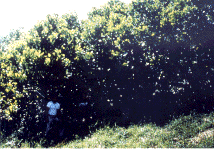
System: Woodlot
Site: Costa Rica
Species: Acacia mangium
Woodlots provide products while decreasing pressure on native forests.
Woodlots are a productive use of poor farmland. Solid stands of trees produce more tree products per hectare annually than other agroforestry systems discussed.
Woodlots are often only very small parcels of land, e.g., in Kenya some lots are only 5m x 5m. Trees are planted close together and are typically uniformly spaced. Woodlots are often harvested on a rotational basis providing a constant supply of fuelwood, poles and other products.
Desirable species for woodlots grow fast and regenerate easily. Important NFT genera for woodlots are Acacia (particularly Australian species), Albizia, Calliandra, Casuarina, Gliricidia, and Leucaena.
These diverse agroforestry systems already play important roles in farming systems world over. Yet they have great potential for further adoption. This is particularly evident in densely populated areas of the tropics.
It is good to keep in mind that planting a number of species of trees, rather than just a few, will bring not only diversified products, but also some protection from possible pests and diseases. Recent world-wide experience with the leucaena psyllid problem highlights the importance of this approach. It is good to plant a variety of species, even within a given planting niche. For example, a fodder bank or hedgerows in the field could be planted with several different species. This could be done in alternating rows for convenience in canopy management, but the trees could even be intermixed within the rows.
